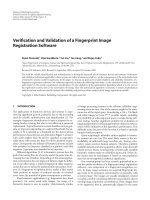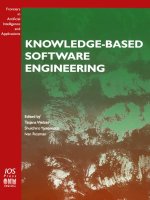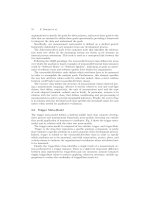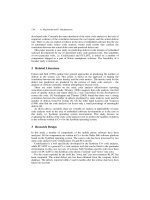Software engineering: Verification and Validation
Bạn đang xem bản rút gọn của tài liệu. Xem và tải ngay bản đầy đủ của tài liệu tại đây (8.6 KB, 7 trang )
<span class='text_page_counter'>(1)</span><div class='page_container' data-page=1>
Verification and Validation
●
Assuring that a software system
</div>
<span class='text_page_counter'>(2)</span><div class='page_container' data-page=2>
©Ian Sommerville 2000 Software Engineering, 6th edition. Chapter 19 Slide 2
Objectives
● <sub>To introduce software verification and validation </sub>
and to discuss the distinction between them
● <sub>To describe the program inspection process and </sub>
its role in V & V
● <sub>To explain static analysis as a verification </sub>
technique
● <sub>To describe the Cleanroom software development </sub>
</div>
<span class='text_page_counter'>(3)</span><div class='page_container' data-page=3>
Topics covered
● <sub>Verification and validation planning</sub>
● <sub>Software inspections</sub>
● <sub>Automated static analysis</sub>
</div>
<span class='text_page_counter'>(4)</span><div class='page_container' data-page=4>
©Ian Sommerville 2000 Software Engineering, 6th edition. Chapter 19 Slide 4
● <sub>Verification: </sub>
"Are we building the product right"
● <sub>The software should conform to its specification</sub>
● <sub>Validation:</sub>
"Are we building the right product"
● <sub>The software should do what the user really </sub>
requires
</div>
<span class='text_page_counter'>(5)</span><div class='page_container' data-page=5>
● <sub>Is a whole life-cycle process - V & V must be </sub>
applied at each stage in the software process.
● <sub>Has two principal objectives</sub>
• The discovery of defects in a system
• The assessment of whether or not the system is usable in
an operational situation.
</div>
<span class='text_page_counter'>(6)</span><div class='page_container' data-page=6>
©Ian Sommerville 2000 Software Engineering, 6th edition. Chapter 19 Slide 41
Key points
● <sub>Verification and validation are not the same thing. </sub>
Verification shows conformance with
specification; validation shows that the program
meets the customer’s needs
● <sub>Test plans should be drawn up to guide the testing </sub>
process.
● <sub>Static verification techniques involve examination </sub>
</div>
<span class='text_page_counter'>(7)</span><div class='page_container' data-page=7>
Key points
● <sub>Program inspections are very effective in </sub>
discovering errors
● <sub>Program code in inspections is checked by a small </sub>
team to locate software faults
● <sub>Static analysis tools can discover program </sub>
anomalies which may be an indication of faults in
the code
</div>
<!--links-->









